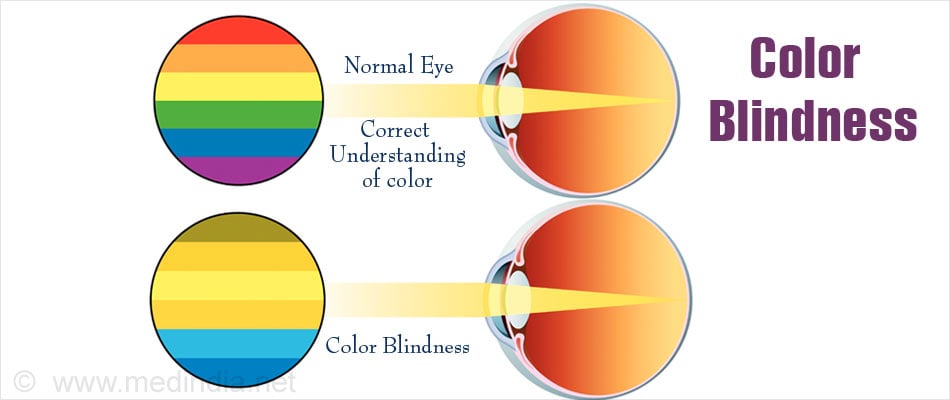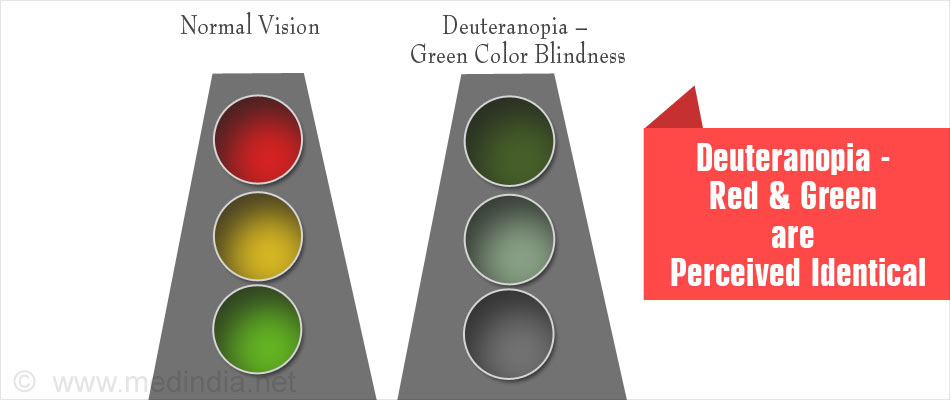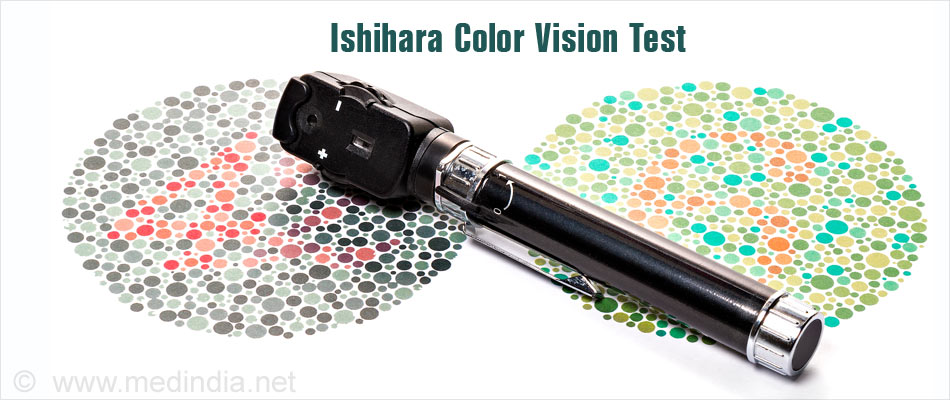- Colour Blindness - (http://www.colourblindawareness.org/colour-blindness/)
- Facts About Color Blindness - (https://nei.nih.gov/health/color_blindness/facts_about)
- What Is Color Blindness? - (https://www.aao.org/eye-health/diseases/what-is-color-blindness)
What is Color Blindness?
Color blindness is the inability of the human eyes to perceive red, blue, yellow or green colors. Color blindness is not a form of blindness, but is the deficiency of the way the person sees colors. Usually, a person with color blindness will have trouble seeing one or two colors and perceives them in a different hue than a person with normal color vision. For example, a person with red-green color blindness may see those colors in hues of blue and yellow.
When a person sees an object, the image of the object is “projected” on the “screen” called retina located at the back of the eye. Retina is a neuro-membrane lining that is made up of two types of photoreceptor cells called Rods and Cones.

The rods are responsible for perceiving objects in dark or at night, and cannot perceive color. There are approximately 120 million rods in each retina. Deficiency of vitamin A leads to poor functioning of rods, thereby causing night-blindness.
Cones perceive colors in the presence of light. There are about 6 to 7 million cones in each retina, concentrated towards the center portion of the retinal screen. Each cone cell is coded with light sensitive pigments to perceive the light of a specific range of wavelengths. The three types of cones cells are:
- S-cones: Sensitive to the wavelength of blue light.
- M-cones: Sensitive to the wavelength of green light.
- L-cones: Sensitive to the wavelength of red light.
The mixing of the information given by these cells makes us perceive the different colors, shades and hues.
The coding of the pigments in cones is determined by the genetic structure of the cells. If something goes wrong with the genetic makeup of the pigments, the colors are perceived in a wrong hue.
What are the Types of Color Blindness?
The functioning of the cones determines the type of color blindness. Categorization based on the missing or malfunctioning of set of cones is as follows:
Monochromatism:
A person with monochromatism would not be able to distinguish any color, usually due to the absence or total malfunction of the cones on the retina. The person is able to distinguish color objects according to their brightness. This type of color blindness is very rare and usually occurs in combination with other vision problems like nystagmus (involuntary eye movements) and astigmatism (an imperfection in eye curvature).
Monochromacy may exist in rods or cones.
- Rod monochromacy is the total absence or non-functional cones, characterized by sensitivity to light (photophobia) and poor vision.
- Cone monochromacy: Unable to distinguish between colors and perceive in shades of black, white and gray, but the ability to see and light sensitivity are within normal limits.
Dichromatism:
A person with dichromatism usually has two functional types of cones and the third type of cones are malfunctioning or missing. The person cannot perceive a specific section of the light spectrum to which the missing cones are sensitive.
However, the sections of light spectrum overlap along the cones. The functional cones combine the color information perceived by them. Color vision deficiencies thus, occur according to the missing hues.
Protanopia – Red Color Blindness: Red cone cells are missing or non-functional in protanopia. Long wavelength perception is impaired and red colors are perceived as beige or gray. The person would be able to view green and blue when presented singly, but if a combination of blue and green is presented, they see it as gray color.
Confusion between colors is seen as follows:
- Most shades of red are perceived as black.
- Dark brown confused with dark shades of green, red and orange.
- Purples with blues, some reds and dark pinks.
- Middle shades of green confused with orange shades.
Deuteranopia – Green Color Blindness: Green cone cells of the retina are non-functional or missing in deuteranopia. When a person with deuteranopia is presented with a mixture of green and red colors, they would not be able to make out the difference.
Confusion between colors is seen as follows:
- Middle shades of green and red colors.
- Blue-greens confused with gray and some pink shades.
- Similar shades of reds and browns.
- Bright greens and yellows appear similar.

Tritanopia – Blue Color Blindness: The person is deficient in blue cone cells and is unable to distinguish between yellow and blue colors. So, greens may appear as blue and yellows appear as pink to their eyes. This type of dichromacy is very rare.
Trichromatism:
Anomalous trichromatism, the faulty perception of colors, is a type of color blindness in which all three types of cells function to perceive light and colors, but there is a shift in the sensitivity of the wavelengths of one of the colors.
The conditions that result from faulty perception of the colors are:
- Protanomaly: There is a reduced sensitivity to red light, resulting in poor red-green hue discrimination.
- Deuteranomaly: There is a shift in the sensitivity to green light and affects red-green discrimination slightly. This is not a severe form of color blindness and is the most common type.
- Tritanomaly: The blue color sensitivity is reduced and there is a reduced blue-yellow discrimination. This is a very rare type of color blindness, is hereditary but not sex-linked.
What are the Causes of Color Blindness?
Color blindness is usually the result of the faulty genetic makeup of the cone cells in the retina. This condition is also inherited. So, color blindness is present in the individual right from birth.
Color blindness that occurs later in life is called acquired color blindness. The causes of acquired color blindness include:
- Chronic illnesses like diabetes mellitus, Alzheimer’s disease, Parkinson’s disease, retinitis pigmentosa.
- Medications when used for a long time, like barbiturates, anti-tuberculosis drugs, medications that help in the treatment of nervous disorders.
- Chemicals – environmental or industrial chemicals like carbon sulphide and carbon monoxide.
- Accidents that cause damage to the eye or restrict blood supply to the eyes.
- Age – as a part of physical changes that occur in the geriatric group.

What are the Symptoms of Color Blindness?
The most obvious symptom of color blindness is difficulty in distinguishing or identifying colors. Since color blindness is usually inherited or genetic, it can be identified early if there is a suspicion of color blindness, using clues like the child’s choice of objects and use of colors.
Some of the clues include:
- The child may have difficulty choosing red and green color crayons or color pencils.
- The child has less attention span or patience for coloring activities.
- The child uses wrong colors in coloring worksheets.
- The child denies any decisions based on color.
- They show a lack of interest in activities related to color, for example sorting games based on colors.
- When light is dim, the color discrimination gets worse.
- Some children may have sensitivity to bright lights.
- Inability to tell the difference between red and green colors or yellow and blue colors.
- Some children use their sense of smell to identify food and usually smell their food before eating.
- The child may complain headache or eyestrain when they are asked to look at something that has only red and green colors.

Some associated characteristics of color blindness are:
- Night vision is relatively much better than day vision.
- The child shows an excellent sense of smell and taste.
How Do You Diagnose Color Blindness?
Diagnosis of color blindness is made using screening and quantitative tests. The screening tests help in identifying color blindness while the quantitative tests help in determining the type and severity of color blindness.
Online color blindness tests are available with various websites, but they are helpful only in screening for color blindness. Further, detailed testing is required to determine the severity of the problem so that coping strategies may be worked out.
- ColorDx Color Vision Test – This is self-administered, self-scoring Android app that can be done at home. It is more useful in detecting acquired color vision deficiencies like diabetic retinopathy multiple sclerosis, macular edema and glaucoma.
- Farnsworth-Munsell 100 Hue test – This is a quantitative color blindness test that consists of four trays with small disks of varying hues. The test helps in determining the type and severity of color blindness in the person.
- Ishihara Color Vision Test – The test consists of a booklet with each page containing a circular pattern made by dots of different colors, sizes and brightness. It may appear to be random, but a person with normal color vision would be able to read a number in the circular plate.
Depending on the types of color blindness, the person would not be able to see certain numbers.

How Do You Treat Color Blindness?
There is no known treatment for congenital color blindness. Some people may use color filter spectacles or contact lenses that can help improve brightness and distinguish between certain shades that look similar.
Coping with color blindness involves understanding the limitations of their own color discrimination. Activities of daily life, like traffic lights, color coding of flavors of food, selecting vegetables based on their colors and other routine work may require an alternative.
Gene therapy for color blindness is still in experimental stages. It involves a process of introducing a photopigment gene that the person with color blindness lacks.
Health Tips
- Eat the right nutrients, especially vitamins.
- Eat fruits and vegetables like papaya, strawberries and carrots that are rich in vitamin A.
- Get your eyes checked regularly for conditions that may cause color blindness like macular degeneration, diabetic retinopathy and cataract.
- Food such as salmon is rich in omega 3 that help in tear production and relieve dry eyes.














